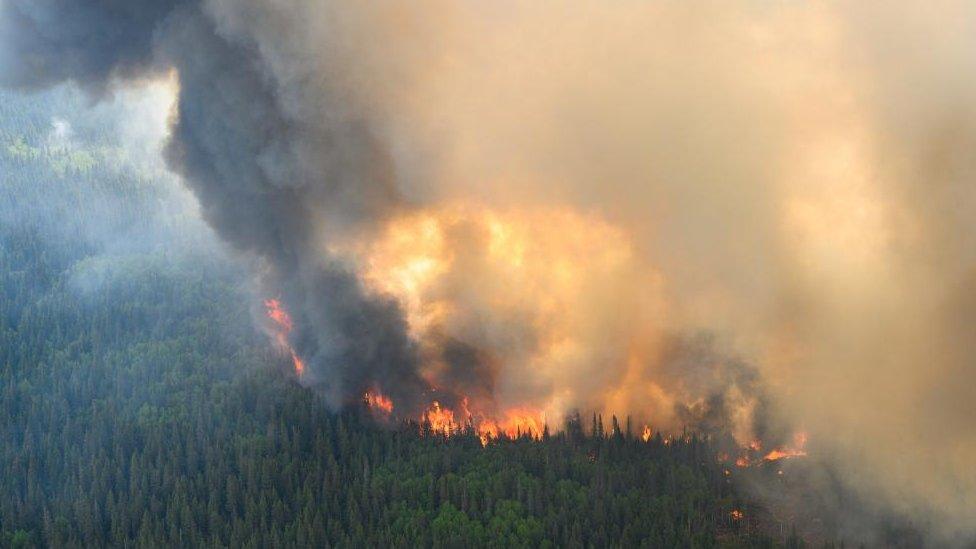Air quality: How to protect yourself from Canada wildfire smoke
- Published
Watch: How to keep safe from wildfire smoke
Millions of people in North America have been warned about the health risks of poor air quality, as toxic wildfire smoke from Canada drifts across the continent.
Conditions were not forecast to be as bad as they were in early June, but the problem may persist for several days.
Here's a closer look at what you can do to stay safe.
How do I check air quality near me?
Air quality updates have become a routine part of many weather forecasts, and the US government has a site where you can check the air quality in your local area, external.
Canadians can check local conditions here, external.
Another useful tool is IQAir's updated rankings for air quality, external in major metro areas around the world.
AQI indicates how clean or polluted the air is around you. The index runs from 0-500 and the higher the number, the worse it is for your health. Anything from 151-200 is designated as "unhealthy".
Should I stay indoors because of wildfire smoke?
It's important to pay attention to local air quality reports like those above and listen to expert advice, external.
When possible, limit your exposure. You might be advised to stay indoors, for example, and keep windows and doors closed.
Matthew Adams, a professor at the University of Toronto and expert on air contaminants, suggests people living in cities far away from the fires but under current air advisories should limit outdoor exercise to avoid breathing in the smoke.
"Don't get so concerned about it," he says, but: "Stay inside and reduce your exposure."
In areas closer to the fires, Prof Adams recommends wearing an N95 mask outside to block inhalation of most of the smoke particles. The US Centres for Disease Control gives the same advice, external and cautions "do not rely on simple dust masks for protection" since they will not protect your lungs from fine particles that are released into the air from wildfires.
Get medical help if you need to.
Should I wear a mask or use an air purifier?
Follow the advice for your local area. You can reduce your smoke exposure by wearing an N95 respirator mask - but you have to make sure you wear it correctly.
It should fit tightly to your face to work well as a filter. They are not designed to fit children though, officials caution, external. They can also make it more difficult for people with certain lung conditions to breathe, says William Barrett, who advises people to check first before using them.
You may consider using a portable air purifier or cleaner in your home or workplace, according to the CDC., external These help remove airborne particles, called aerosols, from the air indoors.

What are the symptoms of smoke exposure?
Wildfire smoke can irritate the eyes, nose, throat and lungs.
It can cause:
cough
headache
scratchy throat
runny nose
stinging eyes
irritated sinuses
wheezing and shortness of breath
Inhaling it can also make your heart have to work harder, raising your pulse, and can sometimes cause chest pain, Prof Adams says.
William Barrett from the American Lung Association says there is a range of negative health effects from breathing in smoke, dust and fine particles.
"They can get deep into our lungs and actually bypass most of the body's defences and they can create a whole range of negative health consequences for the respiratory system," he says. "But also these particles can cross into the bloodstream and actually have an impact on cardiovascular health."
Older people, pregnant women and young children, as well as those with underlying health conditions, such as heart disease or asthma, are more likely to get sick.
Even someone who is healthy can struggle if they are exposed to high levels, though.
Where is the worst air quality in the world?
Major cities in parts of Asia, Africa and Latin America often see dangerous air quality levels similar to what parts of North America are experiencing at the moment.
South Asia is particularly polluted, with a World Health Organization report finding the region suffers an estimated two million premature deaths per year due to air pollution.
The current IQAir rankings show just how much the air quality has dropped in North America in recent days.
For context, there was no North American city in the top 100 most polluted cities in the world in their 2022 report.
Yet on Thursday evening, air quality alerts were in place for all or parts of at least 21 US states and the District of Columbia.
Detroit was ranking first in the world major cities with an "unhealthy" Air Quality Index (AQI) score of 177. Washington DC was in second position, according to IQAir., external
- Published29 June 2023

- Published8 June 2023

- Published8 June 2023

- Published8 June 2023
